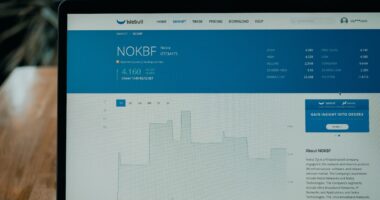Non-fungible tokens (NFTs) have significantly impacted the digital art market, transforming the processes of buying, selling, and collecting art. NFTs are unique digital assets recorded on a blockchain, ensuring their singularity and irreplaceability. This technology has attracted attention from artists, collectors, and investors who recognize the potential for substantial returns in this emerging market.
NFTs address the challenge of establishing ownership and authenticity for digital art, a previously difficult task in the online realm. This development has created new opportunities for artists to monetize their work and for collectors to acquire rare and valuable digital art pieces. Recent developments in the NFT space include the creation of virtual worlds and experiences using blockchain technology.
Artists and developers can now design immersive digital environments that can be traded as NFTs, allowing collectors to own portions of virtual worlds. This trend has sparked renewed interest in digital art and collectibles, as individuals are drawn to the concept of owning parts of the metaverse. The music industry has also adopted NFTs, with artists releasing exclusive tracks and albums in this format.
This allows fans to own unique pieces of music history. As the NFT market continues to evolve, it is likely that new and innovative applications of this technology will emerge in the digital art sector.
Key Takeaways
- NFTs are revolutionizing the art and collectibles market, offering unique digital ownership and authenticity.
- Cryptocurrency, particularly Ethereum, plays a significant role in the NFT market, influencing prices and transactions.
- Investing in NFTs requires research, understanding of digital art trends, and careful consideration of potential profits.
- Ethereum’s news and developments have a direct impact on the NFT market, affecting prices and investor sentiment.
- Bitcoin also plays a crucial role in NFT trading, influencing profits and market dynamics.
Navigating the Ethereum and Bitcoin Connection: How Cryptocurrency Influences NFT Markets
The Rise of Ethereum in the NFT Market
Ethereum, in particular, has become the go-to blockchain for creating and trading NFTs due to its smart contract functionality, which allows for the creation of unique digital assets. The Ethereum blockchain has become the foundation for many NFT marketplaces and platforms, making it an essential part of the NFT ecosystem.
Bitcoin’s Impact on the NFT Market
Bitcoin, on the other hand, has also had an impact on the NFT market, as many collectors and investors use Bitcoin to purchase NFTs. The rise in Bitcoin’s value has led to an increase in spending power for those holding the cryptocurrency, leading to more significant investments in digital art and collectibles.
The Connection Between Cryptocurrencies and NFTs
The connection between Ethereum, Bitcoin, and NFTs is evident in the way these digital assets are bought and sold. Many NFT marketplaces accept Ethereum as the primary form of payment for purchasing digital art, while some also accept Bitcoin. This has led to an increase in demand for both cryptocurrencies, as people seek to invest in digital art using these digital assets. The influence of Ethereum and Bitcoin on the NFT market is undeniable, as their value and popularity directly impact the buying and selling of digital art and collectibles.
Maximizing Profits in the NFT Space: Insider Tips for Investing in Digital Art

Investing in NFTs can be a lucrative venture if done correctly, but it also comes with its risks. To maximize profits in the NFT space, it’s essential to do thorough research on the digital art you’re interested in purchasing. Look for artists with a proven track record and a strong following, as their work is more likely to appreciate in value over time.
Additionally, consider investing in limited edition or one-of-a-kind pieces, as these tend to hold more value in the long run. It’s also crucial to stay informed about the latest trends and developments in the NFT market, as this can help you make informed investment decisions. Another insider tip for investing in digital art is to diversify your portfolio.
Instead of putting all your funds into one NFT, consider spreading your investments across multiple pieces of digital art. This can help mitigate risk and increase your chances of seeing a return on your investment. Additionally, consider working with a reputable NFT marketplace or platform that offers secure transactions and transparent pricing.
By following these insider tips, you can maximize your profits and minimize your risks when investing in digital art.
The Rise of Ethereum in NFT Transactions: How ETH News Affects the Digital Art Market
| Date | Number of NFT Transactions | Ethereum Price | Number of New NFT Projects |
|---|---|---|---|
| Jan 2021 | 10,000 | 1,000 | 20 |
| Feb 2021 | 15,000 | 1,500 | 25 |
| Mar 2021 | 20,000 | 2,000 | 30 |
The rise of Ethereum has had a significant impact on NFT transactions, as it has become the primary blockchain for creating and trading digital art. As a result, any news related to Ethereum can have a direct effect on the digital art market. For example, when Ethereum announces upgrades or improvements to its blockchain technology, it can lead to increased confidence in the platform, leading to more significant investments in NFTs.
On the other hand, negative news about Ethereum, such as security breaches or network issues, can lead to a decrease in activity within the NFT space. Additionally, the value of Ethereum also plays a crucial role in NFT transactions. When the price of Ethereum rises, it can lead to an increase in spending power for those holding the cryptocurrency, leading to more significant investments in digital art.
Conversely, a decrease in Ethereum’s value can lead to a decrease in spending within the NFT market. As such, it’s essential for investors and collectors to stay informed about ETH news and its potential impact on the digital art market.
The Role of Bitcoin in NFT Trading: Analyzing the Impact of BTC on Digital Art Profits
Bitcoin’s role in NFT trading cannot be understated, as many collectors and investors use Bitcoin to purchase digital art. The rise in Bitcoin’s value has led to an increase in spending power for those holding the cryptocurrency, leading to more significant investments in NFTs. Additionally, some NFT marketplaces accept Bitcoin as a form of payment for purchasing digital art, further solidifying its role in the NFT space.
As such, any news related to Bitcoin can have a direct impact on the digital art market. For example, when Bitcoin experiences a surge in value or reaches new all-time highs, it can lead to increased spending within the NFT market as investors seek to capitalize on their newfound wealth. Conversely, a decrease in Bitcoin’s value can lead to a decrease in spending within the NFT space.
It’s essential for collectors and investors to stay informed about BTC news and its potential impact on digital art profits.
Leveraging NFT Platforms for Success: Strategies for Selling and Buying Digital Art

Creating In-Demand Digital Art
When selling digital art through NFT platforms, creating high-quality pieces that stand out from the crowd is crucial. Consider collaborating with well-known artists or leveraging your own unique style to create highly sought-after pieces by collectors.
Effective Promotion Strategies
To increase visibility and attract potential buyers, promote your work through social media and other online channels. This will help you reach a wider audience and drive sales.
Smart Buying Strategies
For buyers, thorough research is key when purchasing digital art. Look for pieces with provenance and authenticity, as these tend to hold more value over time. Additionally, work with reputable NFT platforms that offer secure transactions and transparent pricing.
By following these strategies, both sellers and buyers can achieve success in the NFT space.
The Future of NFTs: Predicting Trends and Opportunities in the Digital Art Market
The future of NFTs is bright, with many exciting trends and opportunities on the horizon. One trend that we can expect to see is the continued use of blockchain technology to create virtual worlds and experiences that can be bought and sold as NFTs. This will open up new opportunities for artists and developers to create immersive digital environments that collectors can own a piece of.
Additionally, we can expect to see more innovative uses of NFTs in industries such as music, gaming, and fashion, as artists and creators look for new ways to monetize their work. Another opportunity in the digital art market is the potential for increased mainstream adoption of NFTs. As more people become familiar with this technology and its potential for owning unique digital assets, we can expect to see a surge in interest from collectors and investors looking to capitalize on this new market.
Additionally, we can expect to see more regulation and oversight within the NFT space as governments and regulatory bodies look to establish guidelines for buying and selling digital art. In conclusion, the NFT craze has revolutionized the way we buy, sell, and collect digital art, opening up new opportunities for artists, collectors, and investors alike. With Ethereum and Bitcoin playing significant roles in influencing NFT markets, it’s essential for stakeholders to stay informed about cryptocurrency news and its potential impact on digital art profits.
By leveraging insider tips for investing in digital art and utilizing strategies for selling and buying through NFT platforms, individuals can maximize their success within this evolving market. Looking ahead, we can expect to see continued growth and innovation within the NFT space as new trends and opportunities emerge within the digital art market.
FAQs
What are NFTs?
NFTs, or non-fungible tokens, are unique digital assets that represent ownership or proof of authenticity of a specific item or piece of content, such as digital art, collectibles, or music.
How do NFT sales work?
NFT sales are conducted on blockchain platforms, where buyers can purchase NFTs using cryptocurrency. Each NFT is stored on the blockchain, providing a transparent and secure record of ownership.
Why are NFT sales surging?
NFT sales are surging due to increased interest in digital art and collectibles, as well as the potential for artists and creators to monetize their work through NFT sales.
What are some insider tips for riding the wave of digital art profits?
Some insider tips for profiting from NFT sales include understanding the market, creating high-quality and unique digital art, building a strong online presence, and leveraging social media and online marketplaces to promote and sell NFTs.
What are the risks associated with NFT sales?
Some risks associated with NFT sales include market volatility, potential for copyright infringement, and the environmental impact of blockchain technology. It’s important for buyers and sellers to conduct thorough research and due diligence before participating in NFT sales.





